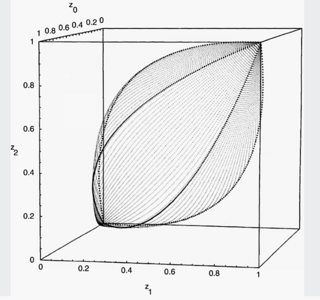Zeta space as a probabilistic model
Consider $ S^n,$ the space of Schur-convex, simply connected, closed topological $n-$manifolds as subsets of the unit $(n+1)-$cube, which include $p=(0,0,\cdot\cdot\cdot,0)$ and $q=(1,1,\cdot\cdot\cdot,1).$ Consider the set of all Schur-convexity preserving maps from $S^n$ to itself.
Define a class of $S^n,$ denoted $\zeta(\mathbf X),$ in the following way:
Let $ L^n_+$ be the set of all $n$-dimensional nonnegative random vectors $\mathbf X = (X_1, X_2,\cdot\cdot\cdot,X_n)^⊤$ with finite and positive marginal expectations, and let $\mathbf Ψ^{(n)}$ be the class of all measurable functions from $\Bbb R^n_+$ to $[0, 1].$ Then $\zeta(\mathbf X)$ of the random vector $\mathbf X$ with joint CDF $F$ is:
$$\zeta(\mathbf X)=\bigg\{\bigg(\int \psi(\mathbf x)dF(\mathbf x), \int \frac{x_1\psi(\mathbf x)}{E(X_1)}dF(\mathbf x),\cdot\cdot\cdot,\int \frac{x_n\psi(\mathbf x)}{E(X_n)}dF(\mathbf x):\psi \in \mathbf Ψ^{(n)}\bigg)\bigg\}, $$
$$ =\bigg\{\bigg(E\psi(\mathbf X), \frac{E(X_1\psi(\mathbf X))}{E(X_1)},\cdot\cdot\cdot,\frac{E(X_n\psi(\mathbf X))}{E(X_n)}:\psi \in \mathbf Ψ^{(n)}\bigg)\bigg\}. $$
Let me provide a concrete example. I have a 3D graph of $\zeta$ for a bivariate II Pareto distribution with parameters $(\mu_1,\mu_2,\sigma_1,\sigma_2)=(0,0,1,1)$ and $\alpha=9$ so I know the qualitative nature of the shape of any given surface given by any distribution. Here is a picture to give some intuition about the definition:
I was interested in obtaining the volume for $\zeta(\mathbf X).$ I calculated it to be:
$$\mathrm{Vol}(\zeta(\mathbf X))= \frac{1}{(n+1)!}E\big(|\det(Q)|\big). $$
where $Q$ is a $(n+1)\times(n+1)$ matrix whose $i$th row is $(1, \mathbf{ \bar X}^{(i)}),$ $i=1,2,\cdot\cdot\cdot , n+1.$
Here I'll use a normalized version of $\mathbf X$ denoted by $\mathbf{\bar X}$ such that $\bar X_i= X_i/E(X_i),$ $i=1,2,\cdot\cdot\cdot, n.$ Consider $n+1$ $\mathrm{iid}$ $n$-dim. random vectors $\mathbf{ \bar X}^{(1)},\cdot\cdot\cdot, \mathbf{ \bar X}^{(n+1)} $ each with the same distribution as $\mathbf{\bar X}.$
I was interested in the Mellin transform of the volume form of $\zeta$ which can be written as:
$$ \Pi_n(s)=\int_{\zeta} x^{s} ~\mathrm{Vol}(\zeta(\mathbf X)) \frac{dx}{x} $$
The reason for investigating this object is to construct a symmetrical completion of $\zeta(\mathbf X)$ in the sense that $\zeta(\mathbf X)$ is just one component in the space. We can add three more of these components to obtain $\zeta_{\mathrm{complete}}.$
Then one can take Mellin transforms of the volume forms on each of the components, paying particular attention to how the mutual intersection volume region transforms into the image space under the Mellin transform. Call this region $R$ which is a subset of $\Bbb C$.
> What can be said about $R$?

.png)

Comments
Post a Comment